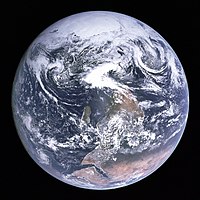| Revision as of 23:23, 25 November 2006 edit213.202.131.13 (talk) →Continents and countries on Earth's Southern Hemisphere← Previous edit | Revision as of 23:26, 25 November 2006 edit undoRettetast (talk | contribs)Extended confirmed users158,862 edits Revert to revision 90109425 dated 2006-11-25 23:22:19 by 213.202.131.13 using popupsNext edit → | ||
| Line 139: | Line 139: | ||
| ] | ] | ||
| ] | ] | ||
| <nowiki><nowiki>Insert non-formatted text here</nowiki></nowiki> | |||
Revision as of 23:26, 25 November 2006
 Map of Earth Map of Earth |
| Longitude (λ) |
|---|
| Lines of longitude appear vertical with varying curvature in this projection, but are actually halves of great ellipses, with identical radii at a given latitude. |
| Latitude (φ) |
| Lines of latitude appear horizontal with varying curvature in this projection; but are actually circular with different radii. All locations with a given latitude are collectively referred to as a circle of latitude. |
|
|
The Southern Hemisphere is the half of a planet's surface (or celestial sphere) that is south of the equator (the word hemisphere literally means 'half ball').
On Earth it contains five continents (Antarctica, Australia, most of South America, parts of Africa and Asia) as well as four oceans (South Atlantic, Indian, Pacific and Southern). Summer is from December to February and winter from June to August.
The Southern Hemisphere is significantly less polluted than the Northern Hemisphere due to lower overall population densities, lower levels of industrialisation and smaller land masses (air currents run mostly west–east so pollution does not easily spread north or south). The southern temperate zone is in fact nearly all water; the only countries that include at least some of this zone are Argentina, Australia, Brazil, Chile, New Zealand, South Africa and Uruguay.
Climates in the Southern Hemisphere tend to be slightly milder than in the Northern Hemisphere. This is because the Southern Hemisphere has significantly less land and more ocean. The water heats up and cools down more slowly than land.
In the Southern Hemisphere the sun passes from East to West through the North (in the tropics the mean Sun may be directly overhead or due South at midday). This causes sun-cast shadows to turn anticlockwise through the day. Hurricanes and tropical storms spin clockwise in the Southern Hemisphere (as opposed to counter-clockwise in the Northern Hemisphere) due to the Coriolis effect. A fact often missed is that in the Southern Hemisphere, the Moon appears to be upside-down compared to viewing from the Northern Hemisphere.
The South Pole is oriented towards the galactic centre and this, combined with clearer skies makes for excellent viewing of the night sky from the Southern Hemisphere, with brighter and more numerous stars.
Continents and countries on Earth's Southern Hemisphere


Continents in the southern hemisphere:
- Antarctica
- Australia Oceania
- most of South America, south of the Amazon river mouth in the east and Quito in the west
- about 1/3 of Africa, south of Libreville in Gabon in the west to south of the southern tip of Somalia in the east
Countries wholly or mostly in the southern hemisphere that are in Asia:
Countries wholly or mostly in the southern hemisphere that are in Africa:
- South Africa
- Namibia
- Botswana
- Lesotho
- Zimbabwe
- Swaziland
- Madagascar
- Angola
- Zambia
- Mozambique
- Malawi
- Democratic Republic of Congo
- Kenya
- Tanzania
- Gabon
- Republic of the Congo
- Rwanda
- Burundi
Countries wholly or mostly in the southern hemisphere that are in Australasia and Oceania:

- Australia
- Cook Islands
- Fiji
- Kiribati
- Nauru
- New Zealand
- Niue
- Papua New Guinea
- Samoa
- Solomon Islands
- Tokelau
- Tonga
- Tuvalu
- Vanuatu
Countries wholly or mostly in the southern hemisphere that are in South America:
Other countries and territories in the southern hemisphere:
- American Samoa
- Antarctic and sub-antarctic islands
- Chagos Archipelago
- Comoros
- Easter Island
- Falkland Islands
- French Polynesia
- Galápagos Islands
- Jarvis Island
- Juan Fernández Islands
- Kerguelen Islands
- Kermadec Islands
- Mauritius, Republic of
- Mayotte
- New Caledonia
- New Zealand sub-antarctic islands
- Pitcairn, Henderson, Ducie and Oeno Islands
- Réunion
- Saint Helena
- Saint Paul and Amsterdam
- Seychelles, Republic of
- South Georgia and the South Sandwich Islands
- Swains Island
- Tristan da Cunha
- Wallis and Futuna

See also
- Seasons
- Solstice
- Equinox
- Tropic of Capricorn
- Crux (or Southern Cross)
| Hemispheres of Earth | |
|---|---|
